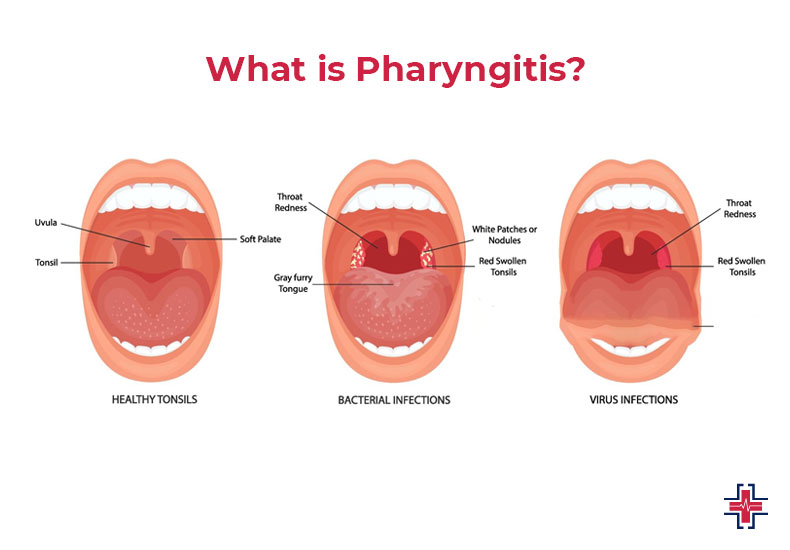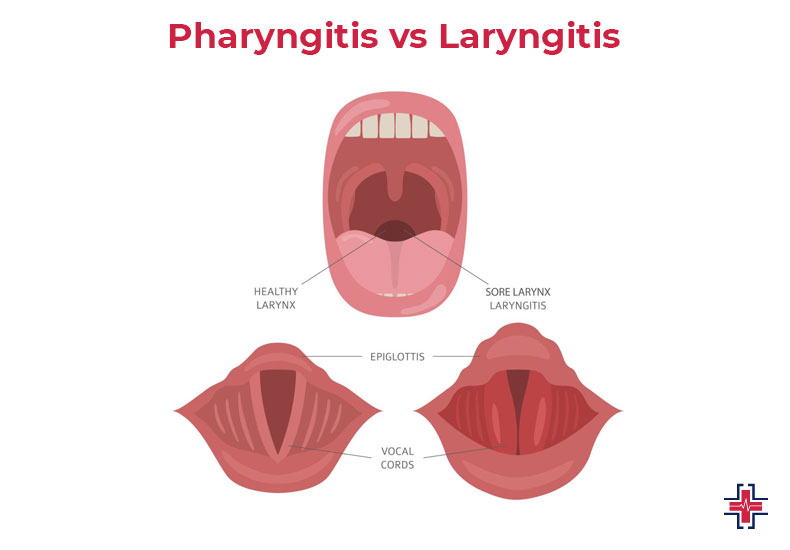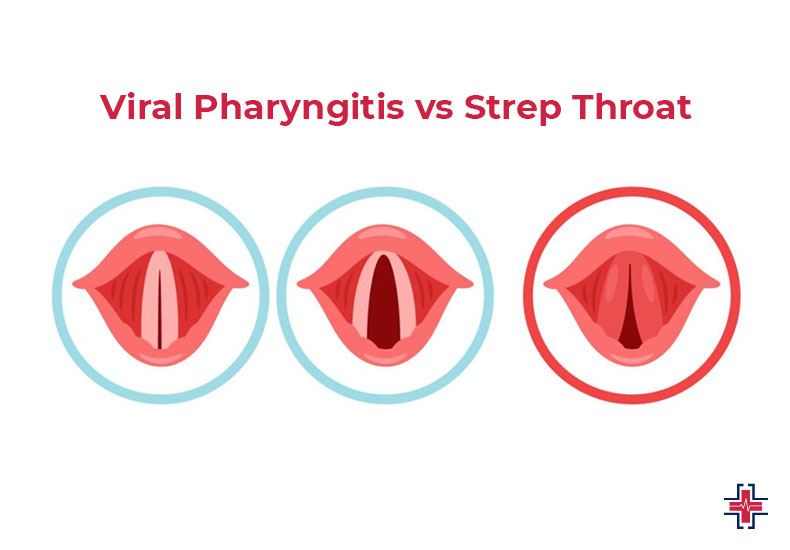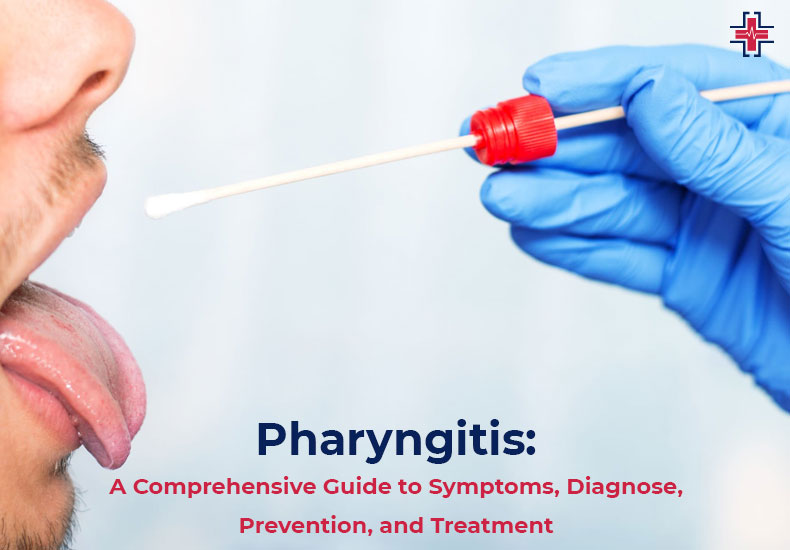What is Pharyngitis?
A sore throat is known medically as pharyngitis. Pharyngitis can be caused by bacterial infections like group A Streptococcus or viral diseases like common colds.
Pharyngitis is a common illness that is rarely a reason for alarm. In most cases, viral pharyngitis goes away on its own in about a week. On the other hand, individuals can focus on their therapy options by being aware of the cause.

The causes, symptoms, and mode of transmission of pharyngitis are examined in this article. We also discuss diagnosis, treatment, and prevention for related illnesses.
Is Viral Pharyngitis Contagious?
It is true that viral pharyngitis, which frequently causes sore throats, is communicable. Viral infections, such as the flu or common cold viruses, are the main cause of this illness and can be transmitted through respiratory droplets. When an infected person coughs, sneezes, or talks, these droplets are expelled, which makes close contact a possible channel of transmission. Viral pharyngitis is contagious during the incubation phase and until the symptoms go away.
This emphasizes the significance of maintaining excellent hygiene, such as frequent handwashing, to reduce the chance of infection transmission. Being aware of how contagious this virus is is essential to taking preventative action against its extensive spread.
What Are The Chronic Pharyngitis Symptoms
Usually, the incubation phase lasts between two and five days. Pharyngitis symptoms can differ based on the underlying ailment.

Apart from a scratchy, dry, or sore throat, a cold or flu can also result in:
- Sneezing
- Runny nose
- Headache
- Cough
- Exhaustion
- Bodily pains
- Fever (higher-grade fever with the flu and lower-grade fever associated with a cold)
The following are additional signs of mononucleosis besides a sore throat:
- Enlarged lymph nodes
- Extreme exhaustion fever aching in the muscles overall malaise
- Appetite loss rash
Another form of pharyngitis called strep throat can also result in:
- A hard time swallowing
- Crimson throat dotted with white or gray areas
- Enlarged lymph nodes
- Fever
- Chills
- Appetite decline
- Nausea
- Strange flavor in the mouth
- Overall ill health
Your underlying health condition will also determine how long the contagious period lasts. You will remain contagious until your fever subsides if you have a viral infection. You could spread the illness from the moment you have strep throat until you’ve taken antibiotics for a full day.
How Is Pharyngitis Diagnosed?
Numerous underlying medical issues might cause sore throats. Even though viral infections are the most frequent cause of pharyngitis, a proper diagnosis is still crucial for effective treatment of the illness.
When diagnosing pharyngitis, a physician will typically start with a physical examination. In addition to reviewing the patient’s current symptoms, they will look for infection-related symptoms in their nose, ears, and throat.
If a patient exhibits unambiguous symptoms of a viral illness, the physician is unlikely to order additional tests.
To be sure of the diagnosis, the doctor may request a throat culture if they think the patient has a bacterial infection. This entails obtaining a throat swab from the subject and sending it to a laboratory for examination.
Physical examination
Your doctor will examine your throat to determine whether you are suffering from pharyngitis symptoms. They’ll look for redness, swelling, and any white or gray areas. Your doctor might also examine your nose and ears. They will feel the sides of your neck for enlarged lymph nodes.
Culture of the throat
Your doctor will probably take a throat culture if they think you have strep throat. This entails taking a sample of your throat secretions with a cotton swab. The majority of physicians can perform a quick strep test in their offices. If the test results indicate a positive result for streptococcus, your doctor will be notified in a matter of minutes.
Transmission of Pharyngitis
Pharyngitis can spread both by bacteria and viruses. The nose and throat are often home to the bacteria that cause pharyngitis.
Affected individuals cough or sneeze, releasing microscopic droplets of the virus or bacterium into the surrounding air. One can contract an infection from:
- Inhaling these little droplets
- Contact infected items, followed by contact with their face
- Eating and drinking tainted food or beverages
For this reason, one must wash their hands before handling food or coming into contact with their face.
Viral infections, like the common cold, typically heal in 7–10 days for most people. However, because of the incubation period of the virus, individuals may be contagious even in the absence of symptoms.
Pharyngitis Prevention
The best approach to avoid sore throats is to maintain proper cleanliness and stay away from microorganisms that cause them. These recommendations could be useful:
- Give your hands a thorough 20-second wash every time, especially after using the restroom.
- Refrain from touching your face. Avoid making contact with your lips, nose, or eyes.
- Steer clear of sharing meals, drinks, and cutlery.
- Sneeze or cough into a tissue paper, then throw it away before washing your hands.
- Clean your hands frequently by using alcohol-containing hand sanitizers.
- Do not use drinking fountains or public phones.
- Keep phone handsets, light switches, remote controls, doorknobs, and computer keyboards clean and sterilized regularly.
- Refrain from being near sick or symptomatic people.
Chronic Pharyngitis Treatment
Viral infections do not create sore throats that can be treated with antibiotics. Furthermore, using antibiotics unnecessarily increases the chance of side effects like rash, diarrhea, and allergic reactions. Viral infections typically cause sore throats that disappear after four to five days. Pain-relieving therapy techniques are among the more effective ones. For example, consider:

- Gargles with salt water: Gargling with salt water has long been used as a treatment for throat pain, even though there is no conclusive proof of its effectiveness in that regard. A solution of 1/4 to 1/2 teaspoon (1.5 to 3.0 g) salt and 1 cup (250 mL) warm water is advised.
- Mouth sprays: Benzocaine and phenol are examples of topical anesthetic sprays that can be used to treat sore throats. Despite this, these sprays don’t work any better than hard candies.
- Lozenges: Topical anesthetics are present in some throat lozenges. They can keep the throat moist and aid in the treatment of throat pain. In addition, lozenges have a longer duration of action than mouth sprays or gargles. Lozenges are therefore more effective.
- Painkillers: Over-the-counter painkillers are an efficient and quick way to treat throat pain. The ailment can be treated with acetaminophen (paracetamol) or a nonsteroidal anti-inflammatory medicine (“NSAID”), such as naproxen or ibuprofen. Oral steroids have advantages, but they should only be used for brief periods due to possible negative side effects.
- Foods and drinks: Chicken soup, warm honey or lemon tea, ice cream, popsicles, and cold drinks can all relieve sore throats.
- Other modes of operation: Supplement and health food retailers both online and offline have products for treating sore throats. These goods may, however, be mislabeled, have incorrect dosage instructions, or include pesticides or herbicides. Furthermore, little research has been done to ensure the efficacy and safety of these products. Consequently, it is not advised to use these kinds of treatments.
Similar Conditions
Inflammation of the throat is a common medical issue, and it can result from a variety of causes. Other possible causes can include:
Pharyngitis vs Laryngitis
Laryngitis is an inflammation of the larynx or voice box. The voice cords are located in the larynx, in front of the throat, and above the windpipe.
Vocal cord inflammation can result in hoarseness and in rare cases, temporary voice loss in some persons. People can strain their vocal cords and develop laryngitis by shouting or using their voice excessively.

Additional reasons for laryngitis include:
- Allergies
- Stomach acid caused by viruses causing acid reflux
- Infections caused by bacteria
Pharyngitis vs Tonsillitis
An inflammation of the tonsils is known as tonsill. Tissue clusters called tonsils are located on either side of the pharynx. One of two infections can cause tonsillitis: bacterial or viral. A group A Streptococcus bacterial infection can also cause bacterial tonsillitis.
Rarely dangerous, tonsillitis frequently goes away on its own or after taking oral antibiotics for a brief time. However, if the disease is chronic or recurrent, a doctor can advise surgical removal of the tonsils. Seven bouts in a year, five in two years, or three in three years can be considered recurrent tonsillitis. The number of absences from school that a child has could also influence a doctor’s recommendation to remove them.

If a tonsil abscess forms, surgical drainage may be necessary.
Pharyngitis and tonsillitis share similar symptoms. Pharyngitis is essentially a subtype of tonsillitis. Among the signs of both are:
- Red, swollen tonsils, and a sore throat
- Tonsil white or yellow spots swallowing difficulties stomach ache
- Headache and neck tightness
Viral pharyngitis vs Strep Throat
A pus-filled lesion on the mouth, voice cords, food pipe, or throat is called an ulcer. Throat ulcer causes include:
- Acid reflux or vomiting-related stomach acid
- Illnesses caused by germs or viruses that harm the throat’s lining tissue
- Chemotherapy
Pharyngitis and throat ulcer symptoms are comparable. Among them are:
- A white patch or soreness in the throat white spots fever
- Nausea
- Chills
- Enlarged lymph nodes

How Long Does Viral Pharyngitis Last
Usually, viral pharyngitis clears up in five to seven days. After taking antibiotics for two to three days, you will feel better if you have bacterial pharyngitis. Even after you start to feel better, you still need to take your antibiotic.
Conclusion
Pharyngitis frequently coexists with colds and the flu and is rarely a serious illness. While bacterial pharyngitis may need to be treated with medicines to avoid problems, viral pharyngitis usually goes away on its own in a few weeks.
Rarely do pharyngitis complications like rheumatic fever occur. Those who experience severe, persistent, or recurrent symptoms ought to consult a physician at the ER of Mesquite – Emergency Room or “contact us” online to book an appointment.
Keeping oneself clean and covering one’s mouth and nose when sneezing or coughing might help stop the transmission of bacteria that can cause pharyngitis.
